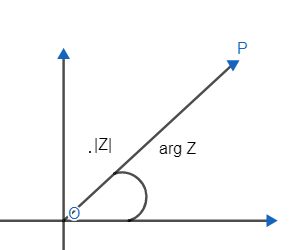
Answer
478.5k+ views
Hint: We will be using the concepts of complex numbers to solve the problem. We will be using a modulus and arrangement way of representing a complex number. We know that the modulus of a complex number Z=x+iy is $\left| Z \right|=\sqrt{{{x}^{2}}+{{y}^{2}}}$ and argument of a complex number is the angle between positive real axis in complex plane and vector OP.
Complete step-by-step solution -
Now, we have been given the modulus and amplitude of a complex number as 2 and $\dfrac{2\pi }{3}$ respectively and we have to find the complex number.
Now, we know that a complex number can be represented as

$Z=\left| Z \right|$ (Cos arg z + i Sin (arg z))…………….. (1)
Where $\left| Z \right|=\sqrt{{{x}^{2}}+{{y}^{2}}}$ is the modulus of the complex number.
$\arg ={{\tan }^{-1}}\left( \dfrac{y}{x} \right)$ and arg z lies between $-\pi $ to $\pi $ also in diagram we can see that arg z is the angle between positive real axis and vector OP.
Now, we have been given that the modulus of complex number is 2 and the arg z is $\dfrac{2\pi }{3}$. Therefore, from (1) the complex number is $Z=2\left[ \cos \left( \dfrac{2\pi }{3} \right)+i\sin \left( \dfrac{2\pi }{3} \right) \right]$ .
$Z=2\left[ -\dfrac{1}{2}+\dfrac{i\sqrt{3}}{2} \right]$ .
$Z=-1+i\sqrt{3}$ .
Hence, the correct answer is option (c).
Note: To solve these types of questions it is important to draw a figure representing the complex number then use the appropriate formula. Like in this case modulus and argument from to represent the answer.
Complete step-by-step solution -
Now, we have been given the modulus and amplitude of a complex number as 2 and $\dfrac{2\pi }{3}$ respectively and we have to find the complex number.
Now, we know that a complex number can be represented as

$Z=\left| Z \right|$ (Cos arg z + i Sin (arg z))…………….. (1)
Where $\left| Z \right|=\sqrt{{{x}^{2}}+{{y}^{2}}}$ is the modulus of the complex number.
$\arg ={{\tan }^{-1}}\left( \dfrac{y}{x} \right)$ and arg z lies between $-\pi $ to $\pi $ also in diagram we can see that arg z is the angle between positive real axis and vector OP.
Now, we have been given that the modulus of complex number is 2 and the arg z is $\dfrac{2\pi }{3}$. Therefore, from (1) the complex number is $Z=2\left[ \cos \left( \dfrac{2\pi }{3} \right)+i\sin \left( \dfrac{2\pi }{3} \right) \right]$ .
$Z=2\left[ -\dfrac{1}{2}+\dfrac{i\sqrt{3}}{2} \right]$ .
$Z=-1+i\sqrt{3}$ .
Hence, the correct answer is option (c).
Note: To solve these types of questions it is important to draw a figure representing the complex number then use the appropriate formula. Like in this case modulus and argument from to represent the answer.
Recently Updated Pages
Who among the following was the religious guru of class 7 social science CBSE

what is the correct chronological order of the following class 10 social science CBSE

Which of the following was not the actual cause for class 10 social science CBSE

Which of the following statements is not correct A class 10 social science CBSE

Which of the following leaders was not present in the class 10 social science CBSE

Garampani Sanctuary is located at A Diphu Assam B Gangtok class 10 social science CBSE

Trending doubts
A rainbow has circular shape because A The earth is class 11 physics CBSE

Which are the Top 10 Largest Countries of the World?

How do you graph the function fx 4x class 9 maths CBSE

Fill the blanks with the suitable prepositions 1 The class 9 english CBSE

The Equation xxx + 2 is Satisfied when x is Equal to Class 10 Maths

Find the value of the expression given below sin 30circ class 11 maths CBSE

What is the length of the alimentary canal in human class 11 biology CBSE

Give 10 examples for herbs , shrubs , climbers , creepers

What is BLO What is the full form of BLO class 8 social science CBSE




